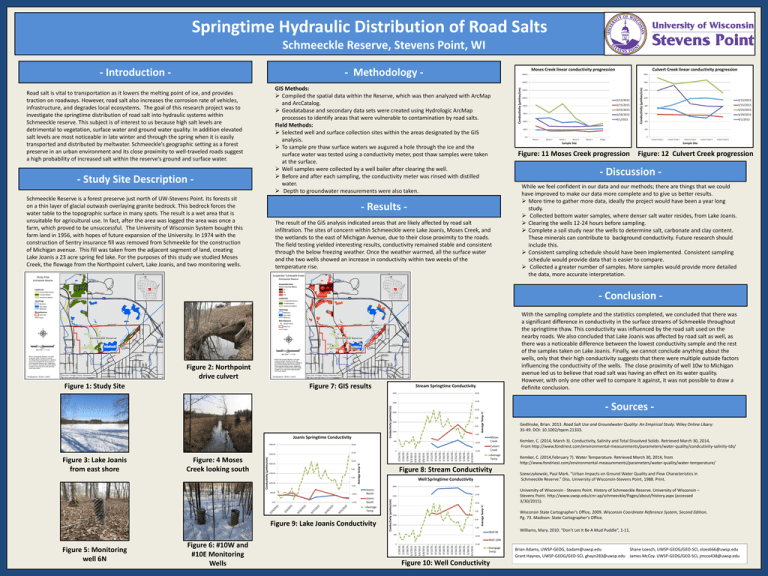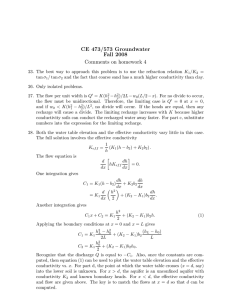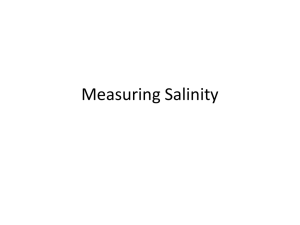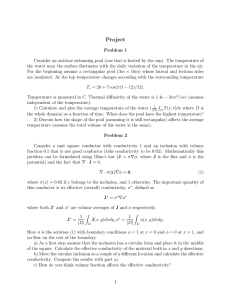Springtime Hydraulic Distribution of Road Salts Schmeeckle Reserve, Stevens Point, WI
advertisement

Springtime Hydraulic Distribution of Road Salts Schmeeckle Reserve, Stevens Point, WI - Methodology - Road salt is vital to transportation as it lowers the melting point of ice, and provides traction on roadways. However, road salt also increases the corrosion rate of vehicles, infrastructure, and degrades local ecosystems. The goal of this research project was to investigate the springtime distribution of road salt into hydraulic systems within Schmeeckle reserve. This subject is of interest to us because high salt levels are detrimental to vegetation, surface water and ground water quality. In addition elevated salt levels are most noticeable in late winter and through the spring when it is easily transported and distributed by meltwater. Schmeeckle’s geographic setting as a forest preserve in an urban environment and its close proximity to well-traveled roads suggest a high probability of increased salt within the reserve’s ground and surface water. - Study Site Description Schmeeckle Reserve is a forest preserve just north of UW-Stevens Point. Its forests sit on a thin layer of glacial outwash overlaying granite bedrock. This bedrock forces the water table to the topographic surface in many spots. The result is a wet area that is unsuitable for agricultural use. In fact, after the area was logged the area was once a farm, which proved to be unsuccessful. The University of Wisconsin System bought this farm land in 1956, with hopes of future expansion of the University. In 1974 with the construction of Sentry insurance fill was removed from Schmeekle for the construction of Michigan avenue. This fill was taken from the adjacent segment of land, creating Lake Joanis a 23 acre spring fed lake. For the purposes of this study we studied Moses Creek, the flowage from the Northpoint culvert, Lake Joanis, and two monitoring wells. - Results The result of the GIS analysis indicated areas that are likely affected by road salt infiltration. The sites of concern within Schmeeckle were Lake Joanis, Moses Creek, and the wetlands to the east of Michigan Avenue, due to their close proximity to the roads. The field testing yielded interesting results, conductivity remained stable and consistent through the below freezing weather. Once the weather warmed, all the surface water and the two wells showed an increase in conductivity within two weeks of the temperature rise. Culvert Creek linear conductivity progression 1600.0 1600 1400.0 1400 1200.0 1000.0 3/12/2015 3/15/2015 800.0 3/25/2015 600.0 3/29/2015 4/1/2015 400.0 Conductivity (µmhos/cm) GIS Methods: Compiled the spatial data within the Reserve, which was then analyzed with ArcMap and ArcCatalog. Geodatabase and secondary data sets were created using Hydrologic ArcMap processes to identify areas that were vulnerable to contamination by road salts. Field Methods: Selected well and surface collection sites within the areas designated by the GIS analysis. To sample pre thaw surface waters we augured a hole through the ice and the surface water was tested using a conductivity meter, post thaw samples were taken at the surface. Well samples were collected by a well bailer after clearing the well. Before and after each sampling, the conductivity meter was rinsed with distilled water. Depth to groundwater measurements were also taken. Conductivity (µmhos/cm) - Introduction - Moses Creek linear conductivity progression 1200 1000 3/25/2015 600 0.0 0 Moses 3 Moses 4 Moses 5 Village 3/29/2015 4/1/2015 400 200 Moses 2 3/15/2015 800 200.0 Moses 1 3/12/2015 Culvert Creek 1 Sample Site Culvert Creek 2 Culvert Creek 3 Culvert Creek 4 Culvert Creek 5 Sample Site Figure: 11 Moses Creek progression Figure: 12 Culvert Creek progression - Discussion While we feel confident in our data and our methods; there are things that we could have improved to make our data more complete and to give us better results. More time to gather more data, ideally the project would have been a year long study. Collected bottom water samples, where denser salt water resides, from Lake Joanis. Clearing the wells 12-24 hours before sampling. Complete a soil study near the wells to determine salt, carbonate and clay content. These minerals can contribute to background conductivity. Future research should include this. Consistent sampling schedule should have been implemented. Consistent sampling schedule would provide data that is easier to compare. Collected a greater number of samples. More samples would provide more detailed the data, more accurate interpretation. - Conclusion - Figure 7: GIS results Stream Springtime Conductivity 3000 20.00 5.00 1500 0.00 1000 500 5.00 1500.00 0.00 1000.00 4/1/2015 3/30/20… 3/28/20… 3/26/20… 3/24/20… 3/22/20… 3/20/20… 3/18/20… 3/16/20… 3/14/20… 3/12/20… 3/10/20… 3/8/2015 3/6/2015 3000 -10.00 Joanis North -15.00 Joanis South Average Temp Figure 9: Lake Joanis Conductivity 10.00 2000 5.00 1500 0.00 1000 Kemker, C. (2014, March 3). Conductivity, Salinity and Total Dissolved Solids. Retrieved March 30, 2014, From http://www.fondriest.com/environmental-measurements/parameters/water-quality/condcutivity-salinity-tds/ Kemker, C. (2014,February 7). Water Temperature. Retrieved March 30, 2014, from http://www.fondriest.com/environmental-measurements/parameters/water-quality/water-temperature/ Szewczykowski, Paul Mark. “Urban Impacts on Ground Water Quality and Flow Characteristics in Schmeeckle Reserve.” Diss. University of Wisconsin-Stevens Point, 1988. Print. University of Wisconsin - Stevens Point. History of Schmeeckle Reserve. University of Wisconsin – Stevens Point. http://www.uwsp.edu/cnr-ap/schmeeckle/Pages/about/history.aspx (accessed 3/30/2015). 15.00 2500 Wisconsin State Cartographer’s Office, 2009. Wisconsin Coordinate Reference System, Second Edition. Pg. 73. Madison: State Cartographer’s Office. -5.00 Well 6E Williams, Mary. 2010. “Don’t Let It Be A Mud Puddle”, 1-11. -10.00 -15.00 4/1/2015 3/30/20… 3/28/20… 3/26/20… 3/24/20… 3/22/20… 3/20/20… 3/18/20… 3/16/20… 3/14/20… 3/12/20… 3/10/20… 3/8/2015 3/6/2015 3/4/2015 3/2/2015 2/28/20… 0 2/26/20… Well 10W 2/24/20… Figure 5: Monitoring well 6N Average Temp 20.00 500 Figure 6: #10W and #10E Monitoring Wells -15.00 Culvert Creek Well Springtime Conductivity Conductivity (µmhos/cm) 0.00 -10.00 Moses Creek Figure 8: Stream Conductivity -5.00 500.00 3/4/2015 2000.00 3/2/2015 10.00 2/28/20… 0 2/26/20… 20.00 15.00 Gedlinske, Brian. 2013. Road Salt Use and Groundwater Quality: An Empirical Study. Wiley Online Libary: 35-49. DOI: 10.1002/tqem.21333. -5.00 Average temp ᵒC Figure: 4 Moses Creek looking south Conductivity (µmhos/cm) Figure 3: Lake Joanis from east shore 2500.00 2000 2/24/20… 3000.00 10.00 Average Temp ᵒC Conductivity (µmhos/cm) Joanis Springtime Conductivity - Sources - 15.00 2500 Average Temp ᵒC Figure 1: Study Site Figure 2: Northpoint drive culvert With the sampling complete and the statistics completed, we concluded that there was a significant difference in conductivity in the surface streams of Schmeekle throughout the springtime thaw. This conductivity was influenced by the road salt used on the nearby roads. We also concluded that Lake Joanis was affected by road salt as well, as there was a noticeable difference between the lowest conductivity sample and the rest of the samples taken on Lake Joanis. Finally, we cannot conclude anything about the wells, only that their high conductivity suggests that there were multiple outside factors influencing the conductivity of the wells. The close proximity of well 10w to Michigan avenue led us to believe that road salt was having an effect on its water quality. However, with only one other well to compare it against, it was not possible to draw a definite conclusion. Avergage Temp Figure 10: Well Conductivity Brian Adams, UWSP-GEOG, badam@uwsp.edu Shane Loesch, UWSP-GEOG/GEO-SCI, sloes666@uwsp.edu Grant Haynes, UWSP-GEOG/GEO-SCI, ghayn283@uwsp.edu James McCoy. UWSP-GEOG/GEO-SCI, jmcco438@uwsp.edu






